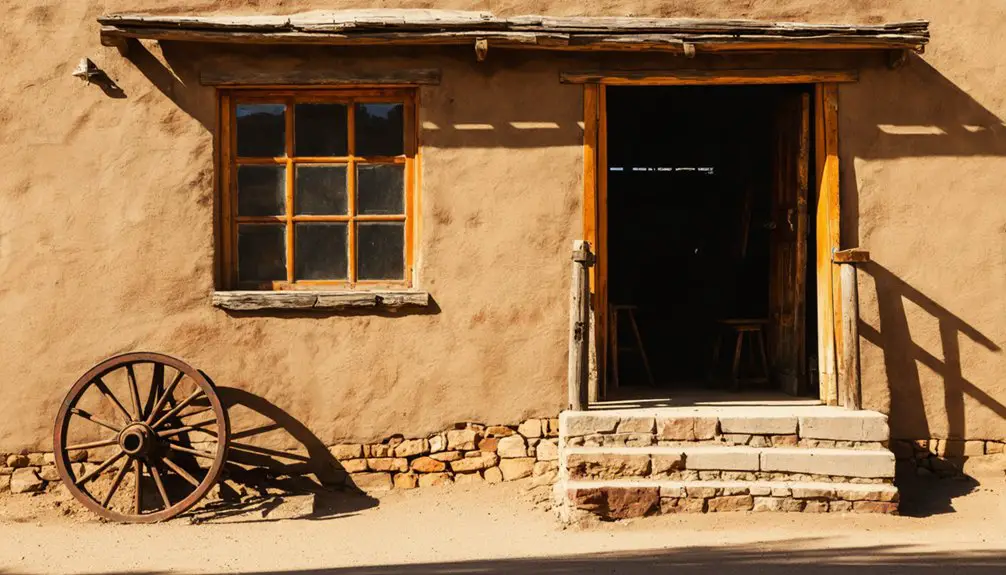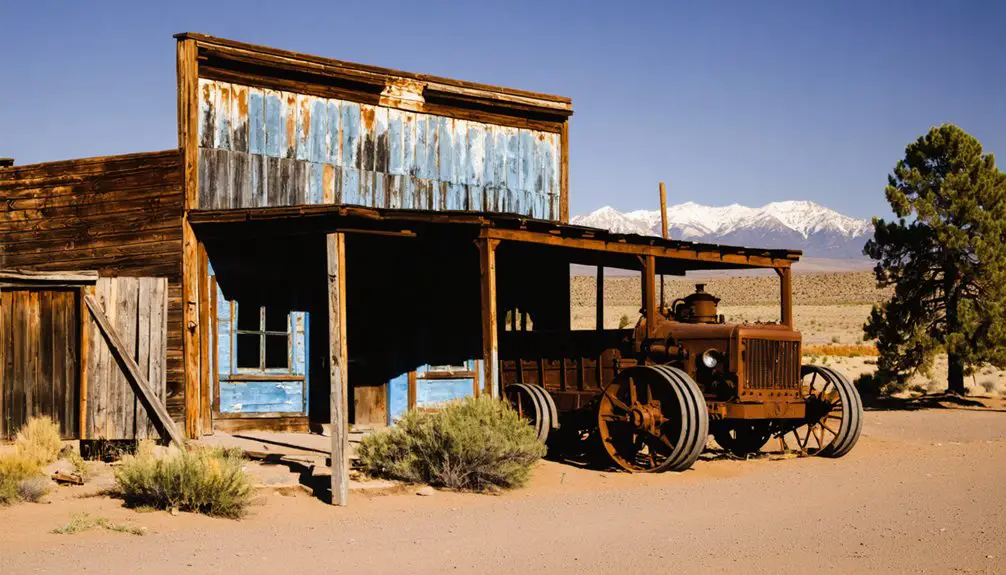You’ll find Pinos Altos, one of New Mexico’s most compelling ghost towns, nestled in the mountains at 7,000 feet elevation. Originally named Birchville after its 1860 gold discovery, the town later adopted its Spanish name meaning “tall pines.” At its peak in the 1880s-90s, it housed 9,000 residents who faced Apache raids, mining hazards, and frontier challenges. The town’s preserved structures and battle sites reveal an epic saga of cultural conflict and mineral wealth.
Key Takeaways
- Pinos Altos transformed from a bustling gold mining town of 9,000 residents in the 1880s to a small ghost town in modern times.
- The town features historic adobe and wooden structures from its mining era, including preserved buildings from the 1860s.
- Located at over 7,000 feet elevation, Pinos Altos originated as a gold mining camp called Birchville before adopting its Spanish name.
- Apache conflicts, mining hazards, and the eventual decline of gold production contributed to the town’s transformation into a ghost town.
- The settlement housed essential amenities like hotels and mercantile establishments, with remnants still visible in the ghost town today.
The Gold Discovery That Started It All
While Mexican government archives trace gold’s presence in the Pinos Altos Mountains to 1837, the area’s mining history began when General Pedro Almendaris, a commandant at Santa Rita, led the initial discovery.
Gold Fever truly erupted in 1860 when prospectors Snively, Birch, and Hicks made their historic find at Bear Creek.
You’ll find historical significance in both discoveries – from the early Mexican encampment’s fortified horseshoe structure to Birch’s chance discovery while drinking from the creek.
The area’s over 7000 feet elevation made mining operations particularly challenging, yet rewarding for those who persevered.
The Mexicans had built a defensive position using logs, rocks, and adobe, complete with shelters and a spring near a cottonwood tree.
Their careful concealment of daily gold panning operations highlighted the precious nature of their find, while internal conflicts over gold transport revealed the intense desires that drove these early prospectors.
A wounded prospector named Adams arrived in 1836 carrying a knapsack of gold, though he died shortly after reaching town.
From Birchville to Pinos Altos: A Name’s Evolution
You’ll find the original mining camp’s history reflected in its evolving name, which began as Birchville in honor of a gold-discovering prospector with a checkered past.
The settlement’s moniker shifted to Pinos Altos in 1866, embracing the Spanish phrase for “tall pines” that Mexican miners had used before the American arrivals. Those once-abundant natural resources sustained a peak population of 9,000 during the 1880s and 90s.
This name change represented more than mere words – it acknowledged the area’s Hispanic mining heritage and the towering ponderosa pines that once dominated the landscape. The establishment of the Pacific Mine by Captain Thomas Mastin marked a defining moment in the town’s early development.
Original Mining Camp Name
The discovery of gold at Bear Creek in May 1860 led to the establishment of a mining camp initially named Birchville, marking the beginning of what would become one of New Mexico Territory’s significant settlements.
Three prospectors stumbled upon the precious metal while stopping for water, and their find quickly drew hundreds of fortune seekers to the area.
You’ll find Birchville’s origins deeply rooted in the rush that followed, as miners flooded the camp seeking their fortunes in the creek’s golden waters.
The settlement’s first name honored one of the key figures associated with its founding, though it would only serve as a temporary identifier.
This early camp, with its makeshift structures and determined prospectors, laid the foundation for what would soon transform into the more formally established town of Pinos Altos. Despite the promise of riches, settlers faced constant threats from Chiricahua Apache raids as they developed the mining camp.
The camp’s rapid growth was evident as over 700 miners arrived to establish more than 30 mines throughout the surrounding area.
Spanish Language Influence
Shifting cultural influences led to the transformation of Birchville’s name into “Pinos Altos,” meaning “Tall Pines” in Spanish – a direct reference to the area’s towering ponderosa pine forests.
This change reflected the cultural persistence of Spanish-Mexican heritage in New Mexico’s mining communities, moving away from Anglo-centric naming conventions. The area’s rapid growth to 700 miners searching for fortune solidified the Spanish name’s widespread adoption.
The name shift wasn’t merely cosmetic. You’ll find that Spanish toponyms like Pinos Altos typically described significant environmental features rather than commemorating individuals.
This linguistic heritage emphasized natural landmarks essential for survival and industry.
When the town rebounded after the Civil War, returning Mexican miners deliberately restored their original naming conventions, demonstrating the enduring influence of Hispanic culture in the region despite Anglo settlement.
Local Legends Behind Names
While Birchville’s founding is well-documented as a mining camp established by three prospectors in 1860, local legends paint a more complex picture of the settlement’s early history and subsequent name change to Pinos Altos.
Local folklore suggests a fascinating cultural significance behind the area’s naming evolution. According to these tales, Mexican miners had already established a fortified camp called “Pinos Altos” before American prospectors arrived.
You’ll discover three key elements of this legendary settlement:
- A horseshoe-shaped fortress built from logs, rocks, and adobe
- A protected spring beneath a large cottonwood tree
- A communal gold storage system that ultimately led to conflict
The mysterious disappearance of these Mexican miners, whether from Apache attacks or internal disputes, left only ruins and stories that would influence the town’s eventual renaming from Birchville to Pinos Altos.
Life in an 1860s Mining Camp
You’d have found Pinos Altos bustling with around 600 residents by 1868, living in 120 houses built from wood and adobe while working the gold and silver mines.
Your daily life would’ve revolved around the constant threats of Apache raids and mining hazards, with the town’s militia companies serving as both protectors and informal leaders. The Arizona Guards militia saved the town during a massive Apache assault in September 1861.
Despite the frontier challenges, you’d have access to essential amenities including two hotels, several mercantile establishments, and four bridges spanning Bear Creek, all supported by the town’s carefully graded streets and multiple water wells.
Daily Miner Camp Life
Life in an 1860s mining camp reflected the harsh realities of frontier existence, where temporary tent settlements could evolve into more permanent communities if ore strikes proved profitable.
Your daily routines would revolve around grueling physical labor, with basic shelter in tents or rough-hewn wooden shacks. Miner camaraderie flourished in the camps’ social hubs, particularly the saloons where you’d spend precious leisure hours. Early photos captured miners using hand-cranked windlass systems to extract ore from the shafts. Former soldiers and freed slaves settled into these camps after the Civil War migration surged in the late 1860s.
Essential aspects of camp life included:
- Working long days using primitive tools for drilling, blasting, and hauling ore in dangerous shaft conditions.
- Hauling water from distant sources and dealing with minimal sanitation facilities.
- Relying on general stores and traders along supply routes for basic provisions, tools, and materials.
You’d find diverse prospectors from various backgrounds sharing these challenging conditions, all seeking their fortune in the frontier mining economy.
Gold Rush Living Conditions
Living conditions in 1860s mining camps reflected stark economic divisions and company control over workers’ daily existence.
You’d find yourself paying $3.50 per room monthly for a basic four to five-room company house, with additional fees for electricity, blacksmithing, and medical services cutting into your wages.
Camp sanitation was poor, with a single water source serving entire communities, leading to widespread health issues and disease outbreaks.
Despite the harsh realities of miner health concerns like lead poisoning and physical dangers both above and below ground, you wouldn’t find churches or proper medical facilities.
Instead, camps prioritized saloons and brothels.
Winter blizzards and summer dust storms made life even more challenging, while the lack of credit systems at company stores forced you to manage carefully what little cash you earned each month.
Frontier Town Social Structure
Despite lacking formal organization until 1867, Pinos Altos developed a distinct social hierarchy shaped by mining operations, militia defense, and cultural tensions.
You’d find community dynamics centered around three key elements:
- The dominant presence of male miners who controlled the town’s economic core through stamp mills, arrastras, and smelting operations.
- Militia leaders who wielded significant influence through the Arizona Guards and Minute Men, establishing a defense-based social order.
- Merchants and business owners who formed an emerging commercial class operating hotels and trading posts.
The Battle That Shaped a Town
While Pinos Altos had endured numerous Apache raids throughout its early years, the battle of September 27, 1861, proved to be a defining moment in the town’s history.
Under the leadership of Mangas Coloradas and Cochise, 300-400 Apache warriors launched a coordinated assault on the mining town, targeting both the camp and settlement.
A massive force of Apache warriors, led by their legendary chiefs, unleashed a strategic attack on the vulnerable mining settlement.
The town’s community resilience showed as defenders, though outnumbered, held their ground. The battle’s turning point came when defenders loaded an old cannon with nails and buckshot, effectively repelling a midday charge.
Despite the town’s successful defense, which demonstrated the settlers’ determination to protect their mining techniques and way of life, the aftermath saw many residents departing for military service, leaving Pinos Altos vulnerable to future conflicts.
Mangas Coloradas and the Apache Resistance

As one of the most influential Apache leaders of the 19th century, Mangas Coloradas emerged as a unifying force among the Central Apache bands through his exceptional diplomatic and military prowess.
His Apache Leadership style combined strategic alliances, including his connection to Chiricahua chief Cochise through marriage, with effective Resistance Strategies against both Mexican and American expansion.
You’ll discover how his impact on the region was defined by:
- His imposing physical presence at over 6 feet tall and reputation as a skilled military tactician
- His initial peaceful dealings with Americans in 1846, granting safe passage through Apache territories
- His transformation into a fierce resistance leader after miners attacked him in 1851, leading to intensified raids and unified Apache opposition against territorial encroachment
Fortifications and Defense Strategies
The settlers of Pinos Altos developed sophisticated defensive measures in response to the mounting Apache resistance under leaders like Mangas Coloradas. They constructed a fortified encampment using logs, rocks, and adobe, while strategically positioning their defenses to take advantage of the ridge-top terrain and clear sight lines through the timbered landscape.
Their defensive innovations included repurposing an old cannon with improvised ammunition like nails and buckshot. Militia tactics emphasized quick mobilization and coordinated responses to raids, with defenders establishing strong positions around the town center.
You’ll find the settlement’s geographic advantages played a vital role, as the elevated position near the Continental Divide provided natural defensive benefits. After 1866, Fort Bayard’s establishment brought additional military support, strengthening the settlement’s overall security against Apache attacks.
Military Presence and Fort Bayard’s Role

Since Apache raids continued to threaten the region’s stability, the U.S. Army established Fort Bayard in 1866, just a few miles from Pinos Altos.
The fort’s military legacy began with the Buffalo Soldiers of the 125th U.S. Colored Troops, who protected miners, settlers, and essential trade routes.
Key aspects of Fort Bayard’s evolution include:
- Distinguished service by Buffalo Soldiers, including Medal of Honor recipient Corporal Clinton Greaves
- Transformation into the nation’s first military tuberculosis hospital in 1899
- Brief reactivation during WWII as a German POW camp housing 100 prisoners
You’ll find the fort’s rich history preserved through monuments honoring the Buffalo Soldiers and structures that witnessed its transformation from a frontier defense post to a medical facility at 6,040 feet elevation.
Preserved Structures and Historical Sites
Walking through Pinos Altos today, you’ll encounter remarkably preserved structures that chronicle its rich mining heritage, from the 1866 Schafer cabin-turned-museum to New Mexico’s oldest operational saloon.
At the Pinos Altos Museum, you’ll find three rooms filled with preserved artifacts, including mining tools, hand-hewn furniture, and period textiles.
The historic Buckhorn Saloon and Opera House maintain their original character after 150 years of continuous operation.
You can explore Fort Cobre’s replica, complete with mining equipment and a simulated mine shaft, offering authentic insights into frontier life.
The 1888 Catholic Church and its adjacent cemetery, with weathered headstones documenting the town’s inhabitants, stand as a testament to the community’s historical significance.
Near the old arrastra, stone remnants of miners’ quarters reveal early mining camp life.
Natural Landscape and Mining Geography
Beyond the preserved historic structures lies a complex geological landscape that has shaped Pinos Altos’s mining heritage for generations. At 6,693 feet elevation, you’ll find yourself surrounded by rugged terrain rich in natural resources including gold, silver, zinc, and copper deposits formed during the Cambrian period.
The district’s distinctive geological features include:
- Granite foundations correlating with the Adirondack and Blue Ridge systems
- Eruptive rock formations encircling the town, except for the southwestern “Malpais” terrain
- A prominent western porphyritic dyke influencing the ore-bearing veins’ patterns
Today’s mining techniques combine underground operations with open-pit excavation, where you’ll observe both conventional mill processing and heap leaching methods.
The surrounding Gila Wilderness adds environmental significance to this historically rich mining district.
Legacy of the Apache Wars
During the tumultuous period between 1849 and 1886, Pinos Altos found itself at the epicenter of the Apache Wars, America’s longest-running armed conflict.
You’ll find evidence of this turbulent era in the town’s militarized past, where cavalry units established outposts to protect miners and settlers from Apache raids.
The Historical Impact of Apache Leadership, particularly from warriors like Cochise, Geronimo, and Victorio, shaped the town’s development.
Apache leaders Cochise, Geronimo, and Victorio profoundly influenced Pinos Altos through their strategic resistance to territorial expansion.
Their resistance to territorial expansion and forced removals led to strategic guerrilla warfare that considerably delayed mining operations and settlement growth.
You can trace the legacy of these conflicts through the network of military trails and defensive positions that once protected Pinos Altos, reflecting a time when the town stood as a frontier flashpoint between Apache warriors defending their homeland and American westward expansion.
Frequently Asked Questions
What Is the Current Population of Pinos Altos?
You’d laugh at how hard it is pinning down your town’s headcount! Current demographics show between 114-182 residents, quite a change from its historical significance as a bustling 1860s mining community.
Are There Any Active Gold Mining Operations in Pinos Altos Today?
You’ll find no active gold mining operations in today’s Pinos Altos, though its historical significance stems from the 1860s mining boom that first established this settlement’s enduring legacy.
What Happened to the Original Cannon Used in the 1861 Battle?
You’d be amazed, but despite the cannon’s historical significance, its exact fate remains a mystery. No surviving records detail its restoration or final location after being stored in Roy Bean’s store.
Can Visitors Pan for Gold in Bear Creek Now?
You’ll need proper permissions to do gold panning in Bear Creek, as the area requires landowner or claim holder approval. Check with local authorities and GPAA regarding current regulations and access.
Which Original Buildings From the 1860S Mining Camp Still Stand Today?
You’ll find two square-hewn log buildings of architectural significance under historic preservation: the 1866 Pinos Altos School on Main Street and John McDonald’s cabin on Spring Street.
References
- https://www.desertusa.com/desert-new-mexico/pinos-altos.html
- https://southernarizonaguide.com/pinos-altos-new-mexico-ghost-town/
- https://newmexiconomad.com/pinos-altos/
- https://readingroo.ms/4/7/6/7/47673/47673-h/47673-h.htm
- https://www.newmexico.org/places-to-visit/ghost-towns/pinos-altos/
- https://digitalrepository.unm.edu/cgi/viewcontent.cgi?article=1643&context=nmhr
- https://www.legendsofamerica.com/red-hill-treasure/
- https://www.mindat.org/loc-21964.html
- https://www.ghosttowns.com/states/nm/pinosaltos.html
- https://elchuqueno.com/city-of-dust-pinos-altos-new-mexico/



